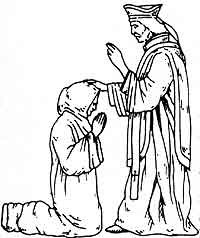 |
 |
 |
 |
 |
 |
 |
 |
 |
 |
 |
 |
 |
 |
 |
 |
 |
 |
 |
 |
 |
 |
 |
 |
 |
|
 |
 |
 |
 |
 |
 |
 |
 |
 |
 |
 |
 |
The place of the priory in the community
|
 |
 |
 |
 |
 |
 |
The Abbot was the overall head of an abbey. The female equivalent was an abbess. In many cases there would be male and female institutions working side by side on the same site, often with the Abbess being in overall control.
The Prior was the abbots deputy who was in charge of discipline. At Tickford, the Abbot was far away in France, so the Prior had a lot of power and freedom to run the priory as he saw fit. The record shows that often what the prior at Tickford thought was fit, wasn't what the local Bishop of community thought was fit. |
 |
 |
 |
 |
 |
Religious orders could benefit the local community in several ways: they were the main centres of education and learning in the middle ages, the sick and needy could find help there, they provided employment to local people, and the rich, by making donations to them, could feel confident that they had ensured a quick passage to heaven on their death. |
 |
 |
 |
 |
 |
 |
 |
The abbot of a wealthy monastery ranked with a baron as a tenant-in-chief under the feudal system. In return for a grant of land various services, even military ones, had to be given to the king. Some of the land could be leased to sub-tenants, such as knights and yeomen farmers. Some monasteries became very rich and powerful through their farming, which included a big part in the wool trade in the later Middle Ages. |
 |
 |
 |
Pictures of an abbot blessing a monk and monks collecting tithes from the local people by D. Mynard, courtesy of MK Parks Trust. |
 |


